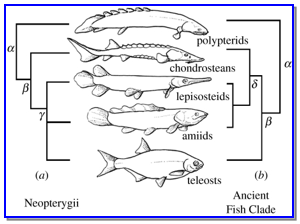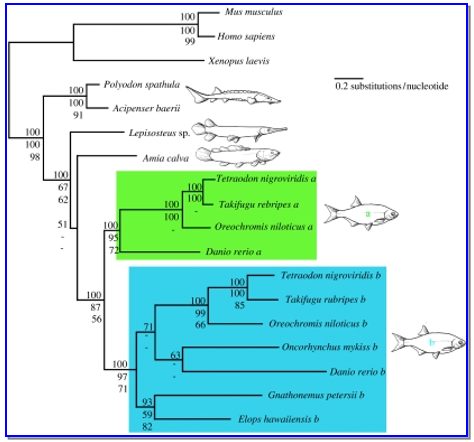Background
Along with Sarcopterygii (lobe-finned fishes and tetrapod offspring), the ray-finned fish Actinopterygii make up the familiar class of bony fishes, the Osteichthyans. Osteichthyans are distinct for having an air sac (a swim or lung bladder but this may be lost) and large dermal bone units on the head and shoulder girdle. In turn, Osteichthyans and the extinct Acanthodian spiny fishes make up the Teleostomi group.
Evolution
The Actinopterygii may be the largest, most varied and presumably most intensively-studied vertebrate group, but there remains much debate about the timing and extent of early evolutionary development. During the Palezoic, their body dermal armor and scales were overlain with ganoln enamel and they had heterocercal caudal fins much like those of Palezoic sharks and the sturgeons of today (Kent and Carr 53-54).
Since divergence dates given by the fossil record are somewhat contradictory, investigators have resorted to morphological, and nuclear and mitochondrial genetic data in an attempt to clarify early evolution and optimize interpretation of experimental data.


In the orthodox presentation of alternative trees and group names of the major living actinopterygian clades, we have (see Figure 1 alongside): polypterids (bichir and reedfish); chondrosteans (sturgeons and paddlefish); lepisosteids (garpike); amiids (bowfin); and teleosts. The bracket α are the Actinopterygii; β, the Actinopteri; γ, the Neopterygii; and δ, the ‘Ancient Fish Clade’.
The Phylogenetic investigation by Hurley et al. (pp. 489 ff.) derived relationships among the actinopterygians from “partitioned Bayesian analysis of 2520bp of concatenated nucleotide sequences of four nuclear genes” (p. 495). All teleosts belong to either the paralogues ‘a’ (green) or ‘b’ (blue), while the amiid, lepisosteid and chondrostean gene record are not part of the teleosts. This suggests that the actinopterygian whole-genome duplication is specific to teleosts. Further, Brachydegma is the marker for both the holostean crown group (Amia separating from Lepisosteus) and the neopterygian crown group. Brachydegmaalso starts the teleost stem group.
Conclusion
Ultimately, one thread of the investigation suggests that, for one, fossil-based estimates for the emergence of the crown-group Neopterygii [covering as well the teleosts, Lepisosteus (gar) and Amia (bowfin)] may be premature by at least at least 40 million years. Neopterygian and teleost crown radiation could well have been a Palaeozoic event but the fossil record has too many gaps to firm up such a conclusion.
Works Cited
Hurley, Imogen A.; Mueller, Rachel L.; Dunn, Katherine A.; Schmidt, Eric J.; Friedman, Matt; Ho, Robert K.; Prince, Victoria E.; Yang, Ziheng; Thomas, Mark G. and Coates, Michael I. “A New Time-Scale for Ray-Finned Fish Evolution.” Proc Biol Sci. 2007; 274(1609): 489–498.
Kent, George C. & Robert K. Carr. Comparative Anatomy of the Vertebrates. New York: McGraw Hill, 2004.